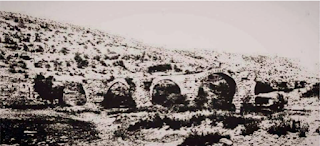Photos by Jack A. Waldron
Now, I am getting confused!! Exactly how many 'Septimius Severus' bridges are there in Eastern Turkey?!? Well, say the road signs, there are three, so far! And most likely, many more, because the Roman Emperor Septimius Severus was very active in northern Mesopotamia.
As with the Septimius Severus Bridge over the Nymphaeum River (aka the Cendere Bridge) and the Septimius Severus Bridge over the Göksu River, the Septimius Severus Bridge over the Karasu River (37°25'59.3"N 37°53'40.6"E) was also built to improve the quick transport of trade goods, materials, livestock, and more importantly the military personnel and equipment over and along the tributaries that emptied into the Euphrates.
Having been born in Leptis (modern day Al-Khums, Libya), where the 3rd Augustan Legion was stationed, Septimius Severus was not only familiar with the Middle East and northern Mesopotamia, after becoming emperor in 193 CE, he was very active in the region.
As a matter of historical geographic importance, not to mention the importance of the construction of all these bridges (and more in the region) by Septimius Severus during his reign, he defeated his rival Pescennius Niger, who had been proclaimed emperor by the Syrian legions, at the Battle of Issus in Cilicia in 194 CE, which is not too distant from the bridge pictured here.
As large swaths of northern Mesopotamia were either directly or indirectly opposed to Rome and/or Septimius Severus, and the fact that a number of the vassal kingdoms supported Pescennius Niger, Septimius Severus sought to further suppress these lands, and to bring them under Roman control.
Later in the year of 194 CE, Septimius Severus moved south from Roman Kommagene, and east from Roman Antiokhia, to annex the Kingdom of Osroene/Osrohene, aka the Kingdom of Odessa, establishing it as a Roman province.
These lands began from the eastern bank of the Euphrates. Just a stone throw from this series of Septimius Severus bridges, and the one pictured here. Pictured above, an undated photo of a semi-intact Septimius Severus Bridge over the Karasu River. Pictured below, the tallest arch of this four/five arched bridge, as seen from northwestern bank.
With regard to the road and its series of bridges crossing the many tributaries that feed the Euphrates along its western bank, it is important to recognize that this road kept all transport within the Roman Empire prior to expansion beyond.
As you can see from these photos, the bridge had reached a state of near complete loss. Who could say when the next excessive flood might wash it completely away?
I have commented on the restoration of antiquities in prior blogs, and I will say again, sometimes they work, and sometimes they don't. The restoration of the right back support wall of the theater at Rhodiapolis ended in pure tragedy, fitting Ashlar Isodomic, Coursed Trapezoidal, Pseudo-Isodomic, and the poorest attempt at 'Lesbian' Polygonal, to a theater requiring pure 'Lesbian' Polygonal blocks up to the analemma back wall.
As long as the restoration is absolutely necessary (as in the case of this bridge), follows the original architectural design (barring historical modifications that make this impossible), and does not detract in the extreme from the aesthetics of the antiquity, well then, go for it.
Most of the upper sections of the bridge were lost, leaving only the tallest of the arches, and the feet of the other arches. Luckily, historical drawings and early photos of the bridge, as well as the one remaining arch, have given the restoration the ability to replicate the original structure.
The Septimius Severus Bridge over the Karasu River was approximately 30 meters long, and 8 meters in height. Pictured above, I am standing on the northwestern bank landing of the bridge looking to the opposite side of the river.
Pictured above, a water spout extends out from the same platform, which is designed to allow rainfall to escape the bridge, as originally, stone hand-rails blocked water from emptying over the edges as it cascaded down the ramparts on either side of the tallest arch (pictured below).
Pictured above, the remaining arch of this four-five arch bridge, which was the tallest. Pictured below, the same arch in an undated photo.
Pictured below, the northwest bank landing platform of the bridge.
As in ancient times, clamps were placed between the cut stone blocks (either made of lead or iron), which helped to hold the structure together.
This bridge being purely Roman, and an important passage south from ancient Samsat to the Zeugma Euphrates crossing and checkpoint into and out of the Empire, it necessarily deserved its dedication. As with the Cendere Bridge, there were two columns at each end of the bridge (totaling four), with one of them being dedicated to Septimius Severus.
Another of the columns was dedicated to his wife, Julia Domna, and the others to his sons Geta and Caracalla, with the dedication to Geta being defeated by Caracalla after Geta had been murdered by his brother.
As you can see from these photos, an awful lot of work went into the restoration of 'portions' of this bridge, but to my surprise, the bridge was only partially restored, and I don't understand how this could have happened. Pictured below, an arial photo (not mine) of the completed incomplete restoration.
This bridge was locally significant during ancient times to modern day Elif, Hisar, and Hasanoglu, of which all three villages contain magnificent ornately sculpted monumental Roman tombs. I will write about these in my next posts!
*All photos and content property of Jack A. Waldron (photos may not be used without written permission)
**Please support my work and future postings through PATREON:
Or, make a Donation through PayPal:
























No comments:
Post a Comment
Note: Only a member of this blog may post a comment.